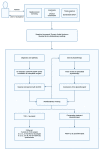General Overview and Diagnostic (Imaging) Techniques for Neurogenic Thoracic Outlet Syndrome
- PMID: 37175016
- PMCID: PMC10178617
- DOI: 10.3390/diagnostics13091625
General Overview and Diagnostic (Imaging) Techniques for Neurogenic Thoracic Outlet Syndrome
Abstract
Thoracic outlet syndrome is an uncommon and controversial syndrome. Three different diagnoses can be made based on the compressed structure, arterial TOS, venous TOS, and neurogenic TOS, though combinations do exist as well. Diagnosing NTOS is difficult since no specific objective diagnostic modalities exist. This has resulted in a lot of controversy in recent decades. NTOS remains a clinical diagnosis and is mostly diagnosed based on the exclusion of an extensive list of differential diagnoses. To guide the diagnosis and treatment of TOS, a group of experts published the reporting standards for TOS in 2016. However, a consensus was not reached regarding a blueprint for a daily care pathway in this document. Therefore, we constructed a care pathway based on the reporting standards for both the diagnosis and treatment of NTOS patients. This care pathway includes a multidisciplinary approach in which different diagnostic tests and additional imaging techniques are combined to diagnose NTOS or guide patients in their treatment for differential diagnoses. The aim of the present work is to discuss and explain the diagnostic part of this care pathway.
Keywords: brachial plexus compression; neurogenic thoracic outlet syndrome; thoracic outlet syndrome; thoracic outlet syndrome additional imaging; thoracic outlet syndrome care pathway.
Conflict of interest statement
The authors declare no conflict of interest.
Figures





References
-
- Sanders R.J., Donahue D.M. Pathology and Pathophysiology of NTOS. In: Illig K.A., Thompson R.W., Freischlag J.A., Donahue D.M., Jordan S.E., Lum Y.W., Gelabert H.A., editors. Thoracic Outlet Syndrome. Springer International Publishing; Cham, Switwerland: 2021. pp. 53–60.
Publication types
LinkOut - more resources
Full Text Sources

